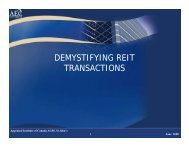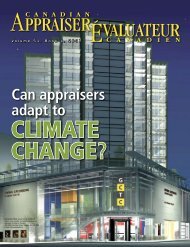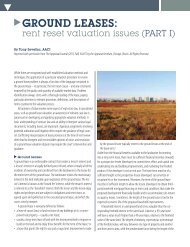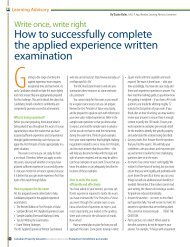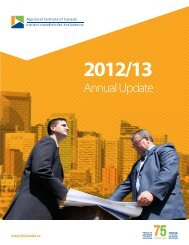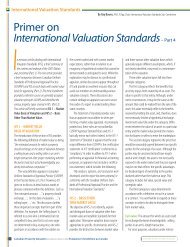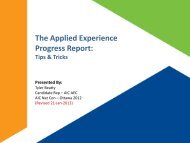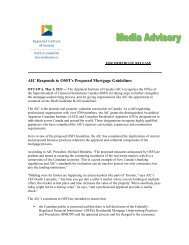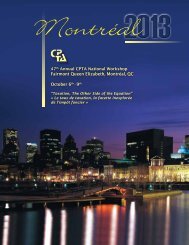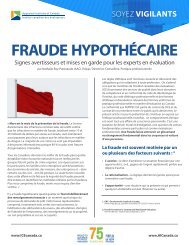Book 2 - Appraisal Institute of Canada
Book 2 - Appraisal Institute of Canada
Book 2 - Appraisal Institute of Canada
You also want an ePaper? Increase the reach of your titles
YUMPU automatically turns print PDFs into web optimized ePapers that Google loves.
equirement for transparency and disclosure<br />
in the Management Discussion and Analysis<br />
(MD&A) section <strong>of</strong> the financial statements,<br />
leaves no doubt members <strong>of</strong> the valuation<br />
pr<strong>of</strong>ession are the best equipped to provide<br />
independent market-based value estimates<br />
and related data and advice. Moreover,<br />
management and boards are going to be<br />
looking increasingly to the valuation pr<strong>of</strong>ession<br />
for provide them with advice and market-based<br />
inputs for their financial reporting.<br />
It would be impossible to cover the subject <strong>of</strong><br />
International Financial Reporting Standards in one<br />
article and, for sure, it would not be me writing<br />
it. What I can convey to the AIC membership<br />
about IFRS is that demand for the services <strong>of</strong><br />
appraisers, or valuers as they are more commonly<br />
referred to outside North America, is going to<br />
increase exponentially. Granted, much <strong>of</strong> this<br />
work will be <strong>of</strong> a commercial nature. However,<br />
let’s not forget that the residential market serves<br />
as security for a great many entities which will<br />
also be reporting under IFRS.<br />
The valuation pr<strong>of</strong>ession will not have<br />
to wait until 2011 to witness an increase in<br />
demand for their services. In fact, demand for<br />
IFRS-prompted services has already occurred in<br />
<strong>Canada</strong>. Consider for example, First Capital Realty<br />
updating the value <strong>of</strong> its properties under IFRS<br />
for the first quarter <strong>of</strong> 2007. The value estimates<br />
used were prepared by independent appraisers<br />
in compliance with IAS 40 - Investment Property<br />
and the International Valuation Standard <strong>of</strong> the<br />
International Valuation Standards Council (IVSC).<br />
Before everyone’s anxiety levels go through<br />
the ro<strong>of</strong>, take comfort in the understanding<br />
that, even if you are reading about IFRS for<br />
the first time, you are not as far behind as<br />
you might think. Consider these observations.<br />
Australian and EU companies adopted IFRS in<br />
2005, with New Zealand adopting them in 2007.<br />
Accountants and appraisers alike can gain from<br />
their experience. As expert as some people are<br />
or will be, IFRS continues to evolve. For example,<br />
according to CA Magazine, between the time<br />
you read this article and January 1, 2011, six<br />
Canadian GAAP standards will change and five<br />
existing IFRS will be modified. While some <strong>of</strong><br />
us have been tracking these events for years, an<br />
understanding <strong>of</strong> the events and changes <strong>of</strong> the<br />
last six months quickly brings one up to speed.<br />
Consider the following events:<br />
• In November 2007, the US Securities<br />
Exchange Commission decided to accept IFRS<br />
from foreign private issuers and these issuers<br />
will no longer be required to reconcile their<br />
IFRS statements to US GAAP.<br />
• In January 2008, the Chartered Financial<br />
Analysts (CFA) announced that, relative to<br />
investments in real estate assets, CFA will<br />
require that independent valuations be<br />
completed every three years and internal<br />
valuations with disclosure <strong>of</strong> underlying<br />
assumptions will be reported quarterly.<br />
• In February 2008, the AcSB confirmed that<br />
IFRS will be adopted in <strong>Canada</strong> effective<br />
January 1, 2011.<br />
• In February 2008, the Canadian Securities<br />
Administrators (CSA) issued a concept<br />
paper containing a tentative conclusion that<br />
financial statements may be prepared under<br />
IFRS for a financial year beginning on or after<br />
January 1, 2009.<br />
• As I write and you read, the International<br />
Accounting Standards Board (IASB), the<br />
organization that issues IFRS, is working on<br />
its Fair Value Measurement project, which<br />
is not only attempting to define fair value,<br />
but the basis <strong>of</strong> its measurement. Even more<br />
exciting, the IASB is openly soliciting input<br />
from valuers and the International Valuation<br />
Standards Council is assisting in this project<br />
as well as providing input.<br />
It is with this backdrop that AIC members<br />
should start preparing themselves for the day that<br />
their client’s management team, chief financial<br />
<strong>of</strong>ficer, accountant, lawyer, or all <strong>of</strong> the above,<br />
phone and want to talk about IFRS-compliant<br />
market-based data inputs and values. No one<br />
is recommending that you go out and try to<br />
memorize the latest copy <strong>of</strong> International Financial<br />
Reporting Standards, International Accounting<br />
Standards (IAS) and accompanying Interpretations,<br />
which by the way, is a hefty 2,500-page<br />
read. However, you might start with some <strong>of</strong><br />
the summaries prepared by the International<br />
Accounting Standards Committee (IASC)<br />
Foundation staff.<br />
The starter reading list might look like this:<br />
IFRS 1 – First-time Adoption <strong>of</strong> International<br />
Financial Reporting Standards<br />
IFRS 5 – Non-Current Assets held for Sale or<br />
Discontinued Operations<br />
IAS 16 – Property, Plant and Equipment<br />
• Initially recognized at Cost<br />
• After recognition, Revaluation at<br />
Fair Value<br />
IAS 17 – Leases<br />
• Operating Leases<br />
• Finance Leases<br />
• Sale/Lease back<br />
IAS 36 – Impairment <strong>of</strong> Assets<br />
IAS 38 – Intangible Assets<br />
IAS 40 – Investment Property<br />
IAS 41 – Agricultural Property<br />
An expanded list might include:<br />
IFRS 3 – Business Combinations<br />
IAS 29 – Financial Reporting in Hyperinflationary<br />
Economies<br />
IAS 32 – Financial Instruments<br />
Let me close by saying, IFRS will undoubtedly<br />
present a mix <strong>of</strong> challenges and opportunities. As<br />
you might have already gathered, there will be no<br />
shortage <strong>of</strong> acronyms to become familiar with. In<br />
short, there is much work to be done. That said,<br />
I believe the real opportunity lies in the reality<br />
that the accounting and valuation pr<strong>of</strong>essions<br />
are going to be working more collaboratively<br />
than ever before. Working through the issues<br />
and challenges together, I believe the resultant<br />
exchange <strong>of</strong> pr<strong>of</strong>essional acumen and best<br />
practises will yield financial statements that users<br />
can better understand and use as a basis for<br />
informed decisions.<br />
Canadian Property Valuation Volume 52 | book 2 | 2008 Évaluation Immobilière au <strong>Canada</strong> 25



